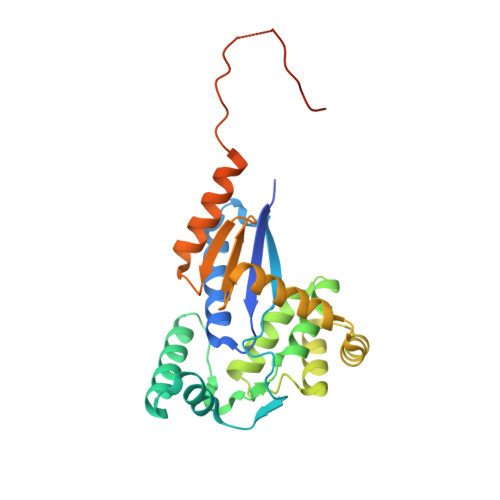drFrnE Represents a Hitherto Unknown Class of Eubacterial Cytoplasmic Disulfide Oxido-Reductases.
Bihani, S.C., Panicker, L., Rajpurohit, Y.S., Misra, H.S., Kumar, V.(2018) Antioxid Redox Signal 28: 296-310
- PubMed: 28899103
- DOI: https://doi.org/10.1089/ars.2016.6960
- Primary Citation of Related Structures:
5CNW, 5CO3, 5COH, 5E59 - PubMed Abstract:
Living cells employ thioredoxin and glutaredoxin disulfide oxido-reductases to protect thiol groups in intracellular proteins. FrnE protein of Deinococcus radiodurans (drFrnE) is a disulfide oxido-reductase that is induced in response to Cd 2+ exposure and is involved in cadmium and radiation tolerance. The aim of this study is to probe structure, function, and cellular localization of FrnE class of proteins. Here, we show drFrnE as a novel cytoplasmic oxido-reductase that could be functional in eubacteria under conditions where thioredoxin/glutaredoxin systems are inhibited or absent. Crystal structure analysis of drFrnE reveals thioredoxin fold with an alpha helical insertion domain and a unique, flexible, and functionally important C-terminal tail. The C-tail harbors a novel 239-CX 4 C-244 motif that interacts with the active site 22-CXXC-25 motif. Crystal structures with different active site redox states, including mixed disulfide (Cys22-Cys244), are reported here. The biochemical data show that 239-CX 4 C-244 motif channels electrons to the active site cysteines. drFrnE is more stable in the oxidized form, compared with the reduced form, supporting its role as a disulfide reductase. Using bioinformatics analysis and fluorescence microscopy, we show cytoplasmic localization of drFrnE. We have found "true" orthologs of drFrnE in several eubacterial phyla and, interestingly, all these groups apparently lack a functional glutaredoxin system. Innovation and Conclusion: We show that drFrnE represents a new class of hitherto unknown intracellular oxido-reductases that are abundantly present in eubacteria. Unlike other well-known oxido-reductases, FrnE harbors an additional dithiol motif that acts as a conduit to channel electrons to the active site during catalytic turnover. Antioxid. Redox Signal. 28, 296-310.
- 1 Protein Crystallography Section, Radiation Biology & Health Sciences Division, Bhabha Atomic Research Centre , Mumbai, India .
Organizational Affiliation:

















